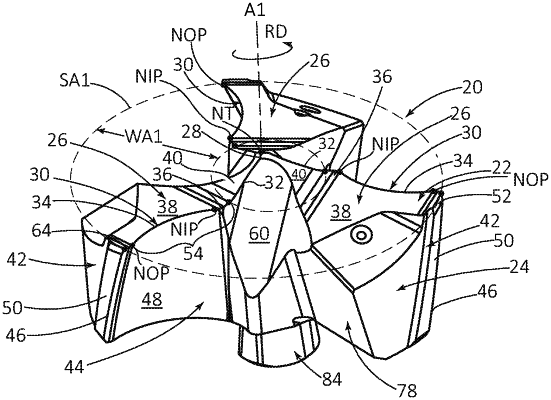| CPC B23B 51/02 (2013.01) [B23B 2251/04 (2013.01); B23B 2251/047 (2022.01); B23B 2251/082 (2013.01); B23B 2251/14 (2013.01); B23B 2251/18 (2013.01); B23B 2251/202 (2013.01)] | 23 Claims |

|
1. A cutting head (20) rotatable about a central axis (A1) in a direction of rotation (RD), the central axis (A1) defining a forward-to-rearward axial direction (DF, DR), and comprising:
a tip portion (22) having an axially forwardmost tip point (NT) contained in the central axis (A1) and three axially forward-facing front surfaces (26) forming three chisel edges (28) extending axially rearwardly away from the tip point (NT),
each front surface (26) having a radially extending cutting edge (30) comprising a secondary cutting-edge portion (32) extending radially outwardly from one of the chisel edges (28), and a primary cutting-edge portion (34) extending radially outwardly either directly from said secondary cutting-edge portion (32) or via a transitional cutting-edge portion (36); and
each front surface (26) further including a primary relief surface (38) adjacent its respective primary cutting-edge portion (34), and
an intermediate portion (24) having three head lands (42) circumferentially alternating with three chip evacuation passages (44), each head land (42) having a leading edge (46) extending axially rearwardly from the tip portion (22), and each chip evacuation passage (44) having a head flute (48) extending axially rearwardly from the tip portion (22) and intersecting one of the leading edges (46),
wherein:
each primary cutting-edge portion (34) has a radially inner primary end point (NIP) and a radially outer primary end point (NOP), and a primary median point (NMP) between said radially inner and outer primary end points (NIP, NOP), the three radially outer primary end points (NOP) defining a first imaginary circle (C1) having a first diameter (D1), the three primary median points (NMP) defining a second imaginary circle (C2) having a second diameter (D2), and the three radially inner primary end points (NIP) defining a third imaginary circle (C3) having a third diameter (D3),
the radially outer primary end point (NOP), the primary median point (NMP), and the radially inner primary end point (NIP) of one of the primary cutting-edge portions (34) are respectively contained in first, second, and third imaginary radial planes (PR1, PR2, PR3), each of the first, second, and third imaginary radial planes (PR1, PR2, PR3) containing the central axis (A1),
each primary cutting-edge portion (34) is contained in a first imaginary annular ring surface (SA1) having a first annular ring width (WA1) spanning at least the radially inner and outer primary end points (NIP, NOP), and
in a front-end view of the cutting head (20), each primary cutting-edge portion (34) is concave,
and wherein:
the first, second, and third imaginary radial planes (PR1, PR2, PR3) intersect the first imaginary annular ring surface (SA1) to respectively form first, second, and third imaginary rectilinear lines (LR1, LR2, LR3), each having a length equal to the first annular ring width (WA1);
in cross-sections taken in first, second, and third transverse planes (PT1, PT2, PT3) perpendicular to the first, second, and third imaginary radial planes (PR1, PR2, PR3) and containing the radially outer primary end point (NOP), primary median point (NMP), and radially inner primary end point (NIP) of the associated primary cutting-edge portion (34), respectively, the adjacent primary relief surface (38) forms first, second, and third acute relief angles (α1, α2, α3), relative to first, second, and third imaginary horizontal reference lines (HL1, HL2, HL3) perpendicular to the central axis (A1), respectively;
an imaginary inclined plane (PI) containing the second imaginary rectilinear line (LR2) forms an inclination angle (π) to the second imaginary radial plane (PR2) and intersects the primary relief surface (38) of the respective front surface (26);
the inclination angle (π) is equal to the second acute relief angle (α2);
in a view perpendicular to the imaginary inclined plane (PI), the radially outer primary end point (NOP) and the radially inner primary end point (NIP) of the associated primary cutting-edge portion (34) are spaced apart from the second imaginary rectilinear line (LR2); and
in a cross-section taken in the imaginary inclined plane (PI), the primary relief surface (38) is convex.
|